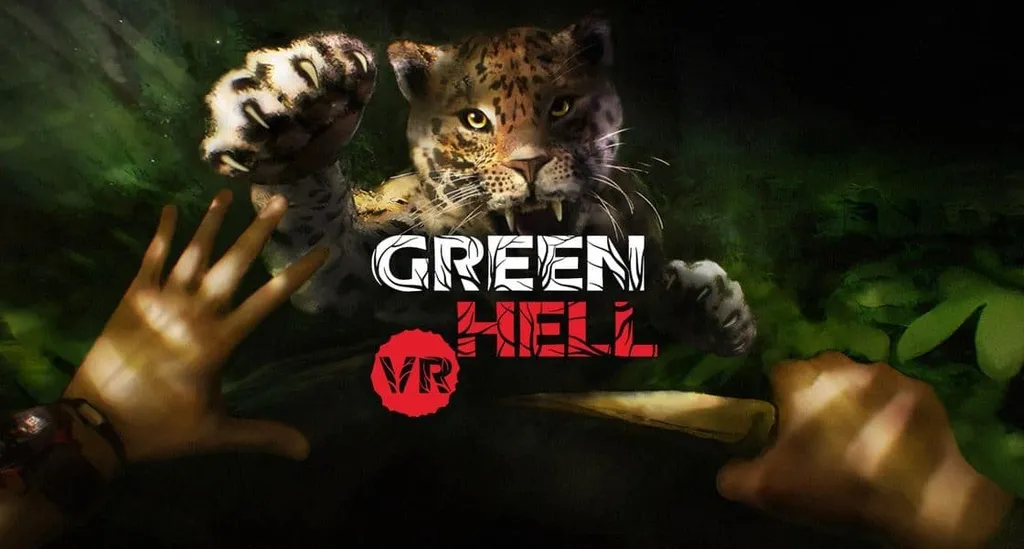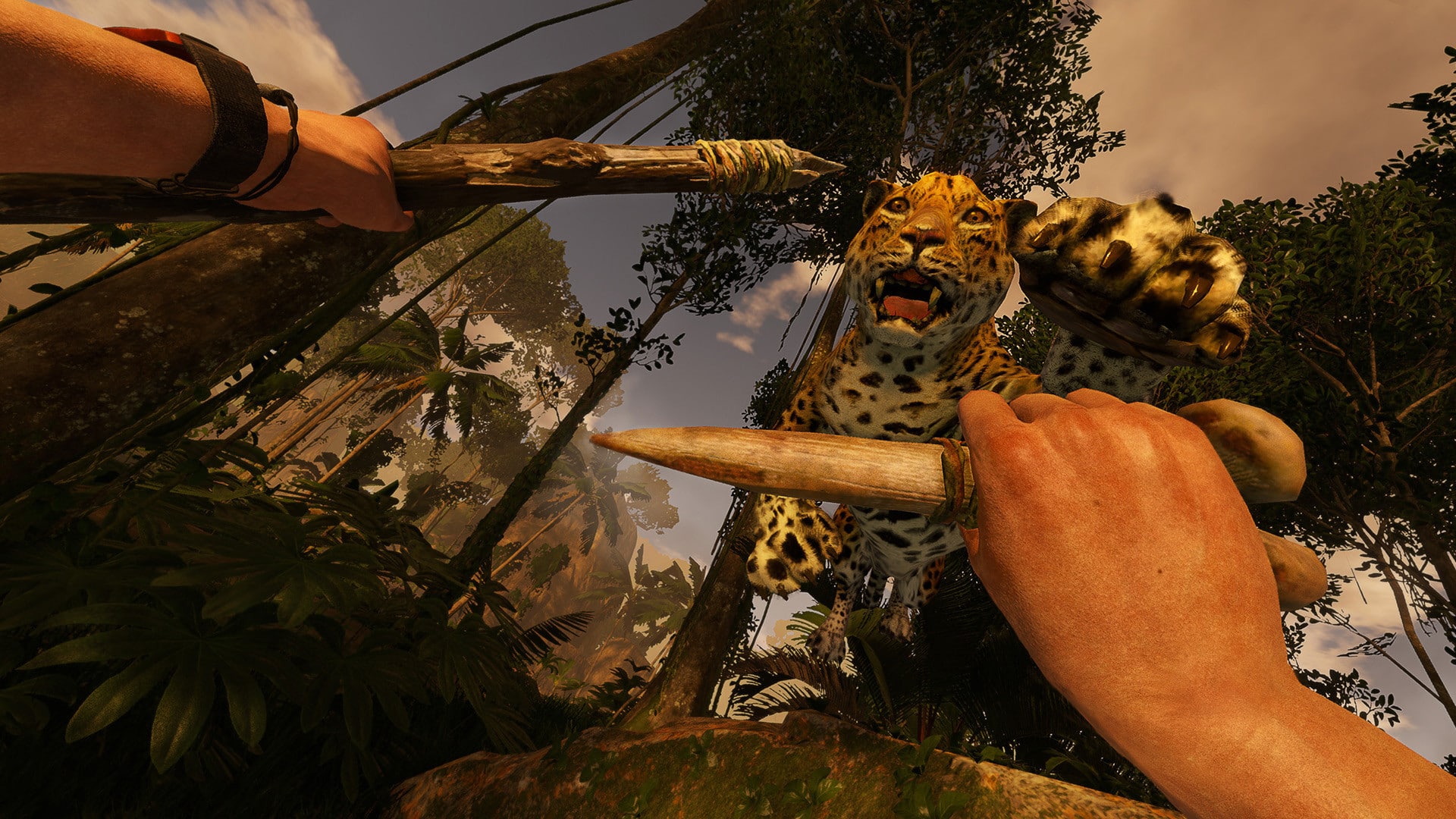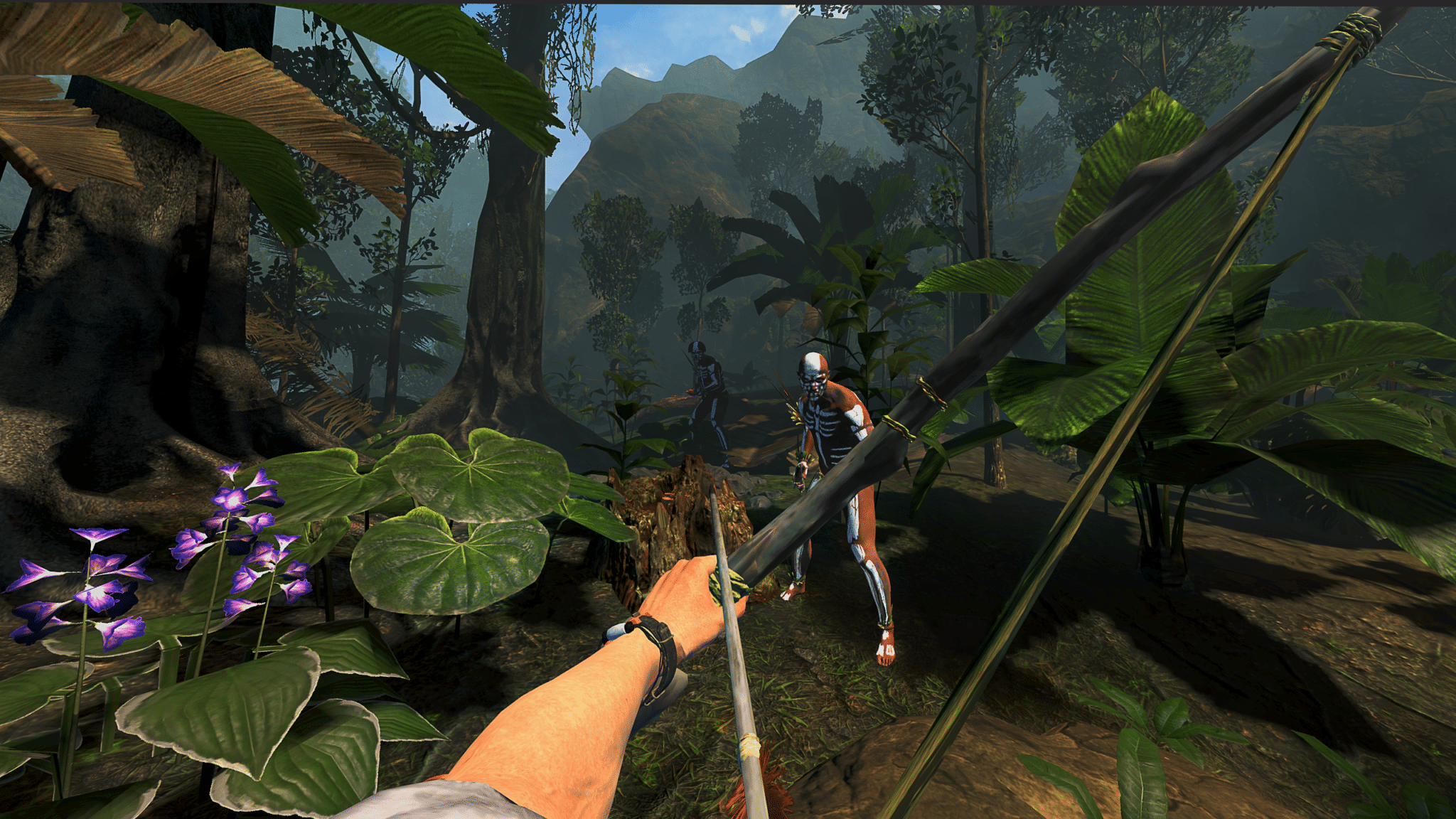Green Hell on Quest isn’t the same game as the flatscreen original, but look past the changes and you’ll find a great VR survival game. Here’s our Green Hell VR: Quest Edition Review.
Let’s get this out of the way first: Green Hell VR’s Quest Edition is not the same experience as the flatscreen game. While this take follows the same core story beats as the original jungle survival title, it’s a more focused and streamlined version that reduces the number of items and structures you can make, threats you’ll encounter and the overall size of the map. It’s an eyebrow-raising move from developer Incuvo (taking over the reins from Creepy Jar), albeit one rooted in sound logic; Quest is a standalone headset after all, and the dense foliage and wide-open areas simply wouldn’t be able to run on the platform without severe performance hits.
And, yes, some of the depth of that initial experience is lost in the transition. The Quest Edition is inarguably shorter and easier than the original. But, — before you grab that pitchfork — I really don’t think you should get too up in arms about these changes. Firstly because a full version of Green Hell in VR with all the bells and whistles is still on its way to PC in a few months’ time, and secondly because the Quest version is actually still a great game in its own right.
One thing that’s unchanged in Green Hell Quest (which is what I’ll call it from now on to avoid confusion with the upcoming PC VR version) is the narrative. You’re still protagonist Jake Higgins, who finds himself separated from his partner, Mia, on a return trip to the Amazonian rainforest and must fight for survival as he searches for a means of escape. If you’ve played the original game then this campaign will play like an abridged version, with many of the key areas of the map returning, only now connected by shorter areas in-between.
[vc_row][vc_column][vc_cta h2=””]Green Hell VR: Quest Edition Review – The Facts
Platforms: Quest 2
Release Date: April 7
Price: $26.99[/vc_cta][/vc_column][/vc_row][vc_row][vc_column][vc_column_text]
Similar, too, is the survival cycle. Getting by day-to-day means Jake will have to build camps, hunt for food and craft resources as he cares for himself. Playing through story mode on the second hardest difficulty, the balance here feels just about right, with enough demand on your nutrient intake to keep it constantly in the back of your mind without getting so demanding as to occupy your every minute, and you’ll quickly make a mental map of which resources are most common and most useful just as you would in, say Song in the Smoke.
It’s in the minutia of these systems that Green Hell Quest sees some key changes.
What you can build and how you build it has been radically overhauled not only to cover for performance but also to reflect the fact that crafting in VR is a much more physical and even tiring process.
A leaf hut, for example, is quickly assembled in the original game by repeatedly chopping away at a tree with a single button press, quickly scooping up the leaves and logs produced as a result with a few clicks, and then instantly throwing it all into the building site to watch it get stitched together. On Quest, every ax swing that hits that tree is from your own movement, and then logs have to be lined up to silhouettes and knocked into place before a rope is wound around joints to bind them and leaves are applied on top.
It’s a much lengthier, more manual process that’s ultimately more rewarding, and the trade-off of requiring fewer resources to actually craft structures is a smart one. There’s nothing more satisfying than the thick thump that comes from knocking a stick into the mud and then winding your arm around two connecting points to tie them up. Incuvo really honed in on how to play to the platform’s strengths in the absence of some other features.
There are other VR-specific benefits, too. Any stone surface in the game can be used to snap tree logs and cut coconuts for example, rather than having to rely on items held in your hand, and you’ll be leaning down to scoop up water into your hands, firing arrows by pulling the bow back yourself, or even accessing your inventory and notebooks much in the same way you did in The Walking Dead: Saints & Sinners.
More controversial are the landscaping changes. As soon as you leave the opening tutorial area it becomes abundantly clear that significant parts of Green Hell’s map have been cut down to size, with the Quest version far more navigable and direct. It’s not quite linear, but you can almost always spot the path you’re meant to take, and most of the important points of interest are spaced out by less than a day’s worth of travel.
And that’s where things start to get a little murky. Less travel time means less stress on your resources; you’ll still need a regular rotation of fats, carbs, proteins, water and sleep, but far more of the map is within reach before any of those meters could drop from a full bar down to a life-threatening depletion. Green Hell Quest is, then, a little less hellish. You can hack your way through the forest in under 10 hours (though it’s still a lengthy game by VR’s standards), but you can still ratchet up the difficulty like you can in other versions of the game to give yourself as demanding a survival experience as possible, should you want it.
With that said, the redesigned levels do mean that the Quest version is able to retain a staggering amount of vegetation and wildlife that really make each of these areas feel alive and far more detailed than a lot of other games on the platform. Leafy greens smother any and every surface and it’s rare not to walk into an area and see a capybara, armadillo or other such critter immediately scatter off. Fish dart back and forth through clear waters and birds hover about treetops and cliff edges almost as if they’re tethered to particular spots. Particularly effective are the smaller nasties like scorpions, spiders and snakes, which have you combing the floor for threats whenever their audio cues trigger.
Not only are these areas aflush with detail but, for the most part, they run incredibly well too. You will notice the game start to stutter if you introduce too many items to an environment and, to that end, the game could use a system for permanently ridding yourself of spoiled food and other wasted items, but I was surprised at just how solid it ran if I wasn’t deliberately trying to push it to its limits.
Some losses are felt more than others, though. The gory gashes and rashes you’ll accumulate on your arms and legs in either combat or adventuring are a particularly masochistic delight in the original game, but they’re stripped back to some cuts and scrapes on your arms here, and some of the hostile creatures have been removed too.
In fact, it’s actually quite rare that you’ll encounter bigger enemies in the game, making the action something of an afterthought. Pumas and Jaguars are still likely to cut straight through you if you’re not properly prepared but I also encountered hardly any human enemies in my playthrough. I suspect that may have something to do with how primitive the hack n’ slash combat feels in VR, whereas the other survival elements still thrive.
Still, it’s by no means a pushover – even one attack from a predator can mean quickly bleeding out and slipping off of a log most likely means saying goodbye to a large chunk of your health bar.
As you can probably tell, then, the scales are constantly tipping back and forth on Green Hell Quest. Some of the cuts made to this version really sting, whereas the game also gains a lot from the added VR interactions. Set all that aside for a second, though, and imagine there wasn’t an original version of the game to compare this to. Would there actually be a fun VR survival title here?
My answer to that would be a resounding yes. This is still a deep and taxing survival game that proves to be an impressive showcase for just how large and detailed environments can be on Quest 2 and, beyond the story mode, there’s also the straight up survival mode that lets you revisit the game to push yourself further, should you wish.
Green Hell VR: Quest Edition Review – Final Impressions
Green Hell on Quest is a game you have to take on its own merits. Similar to how Superhot VR offered a streamlined take on a strong central idea, this chops away at the original game’s foundations to deliver a focused version of a great survival game. True, it’s a much more straightforward experience with simpler crafting and fewer threats, but the meticulous attention paid to VR interaction and physicality, not to mention the still-impressive scale and performance makes this one of the better flatscreen conversions VR has seen over the past few years. If you really don’t want to compromise on the original experience in VR then you should wait for the PC VR version arriving later down the line but, for anyone interested in a more tailored title, Green Hell’s Quest version is a worthy rumble through the jungle.
UploadVR recently changed its review guidelines, and this is one of our new Recommended review labels. You can read more about our review guidelines here.
This review was conducted on the Quest 2 version of the game. What did you make of our Green Hell VR: Quest Edition review? Let us know in the comments below!




























